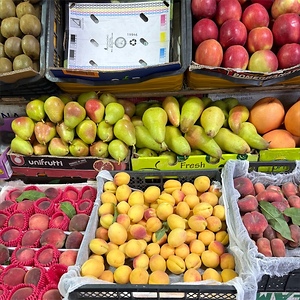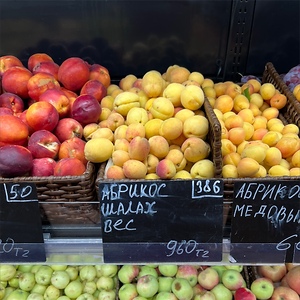


Shalakh Apricots
Estimated Inventory, lb : 0
Description/Taste
Shalakh apricots are larger than other commercial apricots and have an elongated, oval to oblong shape with blunt, curved edges. The fruits range from 50 to 100 grams in weight and generally have a uniform appearance featuring a prominent suture line extending the length of the apricot. The fruit’s skin is semi-thin, taut, and firm, showcasing a lightly bumpy, velvety, and matte feel. The skin showcases a light orange, yellow, or pink-yellow hue and is occasionally blushed with dark red, crimson patches, developed from extended sun exposure during cultivation. Underneath the surface, the yellow-orange flesh is aqueous, moderately fibrous, and succulent with a crisp, slightly chewy consistency. The flesh can become overly fibrous as the variety ages and develops white veining. The flesh also encases a brown pit, encasing a seed. This pit is easy to separate from the flesh. Shalakh apricots are edible raw or cooked when ripe and release a fruity, sweet aroma with pineapple-like nuances. The flesh has a balanced ratio of sugar and acidity, creating a sweet, subtly sour flavor.
Seasons/Availability
Shalakh apricots are available in the summer, typically between June and August. Each growing region will have varying harvest dates within this range.
Current Facts
Shalakh apricots, botanically classified as Prunus armeniaca, are an early to mid-season variety belonging to the Rosaceae family. The fruits grow on trees reaching 4 to 5 meters in height and are valued as a commercial cultivar for their large size and sweet, subtly tart flavor. Shalakh apricot trees bear fruit four years after planting, and once mature, the trees can produce 150 to 400 kilograms of fruit per season. The cultivar is known for its high yields, easy-to-grow nature, and disease resistance. Shalakh apricots are primarily grown in Central Asia and Eastern Europe and are sourced for fresh retail sale and processing, mainly dried or canned. When sold fresh, Shalakh apricots are versatile and are incorporated into a wide array of fresh and cooked, sweet and savory preparations.
Nutritional Value
Shalakh apricots have not been extensively studied for their nutritional properties. Apricots, in general, are a source of fiber to aid digestion and vitamins A, B, C, and E to contribute to energy production, maintain healthy organs, and strengthen the immune system. Apricots also provide minerals like copper, manganese, potassium, magnesium, iron, calcium, and phosphorus. Copper assists the body in producing red blood cells, manganese helps with metabolism, and potassium balances fluid levels within the body. Iron develops the protein hemoglobin for oxygen transport through the bloodstream, magnesium controls nerve functions, while calcium and phosphorus support bone and teeth health.
Applications
Shalakh apricots have a sweet, subtly tart flavor suited for fresh, cooked, and dried preparations. The variety is favored for its taste and aroma and is eaten out of hand as a snack. Shalakh apricots are also sliced, pitted, and tossed into salads or used as a topping over parfaits and oatmeal. In addition to fresh uses, Shalakh apricots are popularly simmered into preserves like jams, compotes, purees, and marmalades. They are also caramelized and poured as a topping over cakes, ice cream, or tarts. Try halving and grilling apricots and serving with walnuts and cream. Slices of the fruit are also incorporated into savory dishes with roasted meats like lamb. In Armenia, apricots are cooked with lentils and put into a savory soup. They are also added to various traditional desserts. Beyond cooked dishes, Shalakh apricots are notably processed into canned fruits or dried for extended use. Dried fruits can be eaten as a sweet treat or chopped into granola and homemade bars. They are also mixed into grain-based dishes and cooked as a sweetener in sauces. Shalakh apricots pair well with other fruits like citrus, peaches, strawberries, and nectarines, aromatics such as onions, garlic, and ginger, and spices including parsley, cumin, and thyme. Whole, unwashed Shalakh apricots will keep up to seven days when stored fresh. The variety has a short shelf life and should be immediately consumed once ripe for the best quality and flavor.
Ethnic/Cultural Info
Shalakh apricots are also cultivated under the name Yerevani apricot, a moniker acquired from their site of origin in Yerevan. Apricots are considered Armenia’s national fruit and are prized for their sweetness and history of cultivation in the country. Some residents allude that the orange band featured on the Armenian flag is similar to the color of apricots, further intertwining the fruits with the country’s cultural lore. While the orange band was placed on the flag to symbolize other aspects of the country, apricots have remained a prevalent fruit in the traditions of Armenia. Shalakh apricots are also nicknamed the pineapple apricot in commercial markets for their fragrant, sweet, and fruity aroma.
Geography/History
Shalakh apricots are believed to be native to Armenia, but the origins are sometimes debated by scientists. The most well-known theory traces the variety to the city of Yerevan, which is the capital of Armenia and is located in the Ararat Valley. It is unknown when the variety was bred, but by the early 20th century, Shalakh apricots were planted in the Nikitsky Botanical Garden in Crimea, one of the oldest botanical gardens in Europe. Shalakh apricots were also trialed in Russia by the late 1930s, and since their introduction, the variety has spread as a favored commercial and home garden fruit. Today, Shalakh apricots are cultivated throughout Eastern Europe and Central Asia, primarily in warm regions suited for apricot production. The variety is sold fresh or processed for commercial goods. When in season, Shalakh apricots are a delicacy found through local markets and directly through growers.









